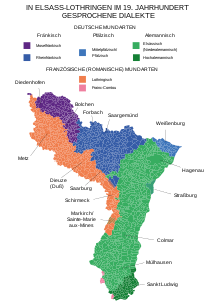Language border

A language border runs through a geographical area in which two or more population groups meet who speak different (foreign) languages and where communication is not possible even on a dialectal level.
In Europe there are many language borders, such as the German-French language border or the German-Polish language border or, broadly speaking, the Germanic-Romance or Slavic-Germanic language borders. Language borders are often, but not always, congruent with national borders.
In contrast, there are no language or dialect boundaries within a dialect continuum , even if the dialect speakers from widely separated dialect areas can hardly understand each other.
Germany
There are only a few language borders within Germany, for example the German- Sorbian language border in the east or the Sater Frisian- German language border in East Frisia.
For centuries, the Eider marked the language border between German , more precisely Low German , and Danish .
On the other hand, the Benrath line (maken-making border), named after the Düsseldorf district of Benrath , represents a transition from the High German to the Low German and Lower Franconian dialects and was established here to delimit linguistic research areas from one another. But it is not a language border and also not a real dialect border between the Lower Franconian, Low and High German language areas , as there is a dialect continuum . The so-called “make-make-border” begins in Eupen, Belgium.
Belgium
A very important Romansh-Germanic language border, burdened by many political conflicts, runs through Belgium . It divides the country into a Walloon ( French-speaking ) and a Flemish ( Dutch- speaking ) part. In the Belgian capital Brussels , where the Lower Franconian dialects were originally spoken, now mostly French-speaking residents live. It has thus become a “linguistic enclave ” in the middle of Flanders, although this view is put into perspective when you consider that there are now many French native speakers in many of the surrounding Flemish communities. The Flemish Community and the French Community each have their headquarters in Brussels. Around 59 percent of Belgians speak Dutch as their mother tongue and around 40 percent speak French as their mother tongue.
Another Romance-Germanic language border in Belgium is the French-German language border in the east of the country between the Walloons and the German-speaking population in East Belgium ( German-speaking Community of Belgium ). The German minority makes up just under one percent of the total Belgian population. The Franco-German language border is marked by far fewer political conflicts than the Franco-Dutch border.
Switzerland
At the federal level, there are four official languages in Switzerland, namely:
- German , in German-speaking Switzerland (orange),
- French , in French- speaking Switzerland or French- speaking Switzerland (green),
- Italian , in Italian Switzerland (blue),
- Romansh , in Graubünden (purple).
The language borders in Switzerland do not follow any political borders (cantonal borders). A language boundary z. B. the canton of Valais and divides it into the German-speaking east (Upper Valais) and the French-speaking west (Lower Valais). Since the language border runs partially within the canton, it can happen that this is shifted. B. in the city of Biel. The city is located in the bilingual canton of Bern on the edge of the French-speaking Bernese Jura. Originally the townspeople were German-speaking, only with the immigration of French-speaking watchmakers from the Jura did the town become bilingual over time. Something like this can still happen today, as each municipality can choose its own official language (s).
There are four language borders in Switzerland:
- between German-speaking Switzerland and French-speaking Switzerland (German / French), is also called "Röstigraben";
- between German-speaking Switzerland and Italian-speaking Switzerland (German / Italian);
- between German-speaking Switzerland and the Romance-speaking area (German / Romansh);
- between Italian-speaking Switzerland and the Romance-speaking area (Italian / Romansh).
France
Although there are several language borders in France, French is the official and school language for all French citizens. There is a significant language border in Alsace-Lorraine (German and French).
Italy
The Dolomites (South Tyrol) roughly form the language border between German and Italian. Ladin is still spoken in the Dolomite valleys of Val Gardena and Alta Badia. Roughly speaking, there is a language border along the Dolomites between Italian, German and Ladin.
Web links
- Bert Alexander Schwank: Grenzgeschichte - The borders of Germany and the German-speaking area in history . Author's website, September 18, 2011.
Individual evidence
- ↑ Languages in South Tyrol: German, Italian and Ladin . suedtirol.info, accessed on March 16, 2018.
- ↑ Dolomites . eppan.travel, accessed on March 16, 2018.


